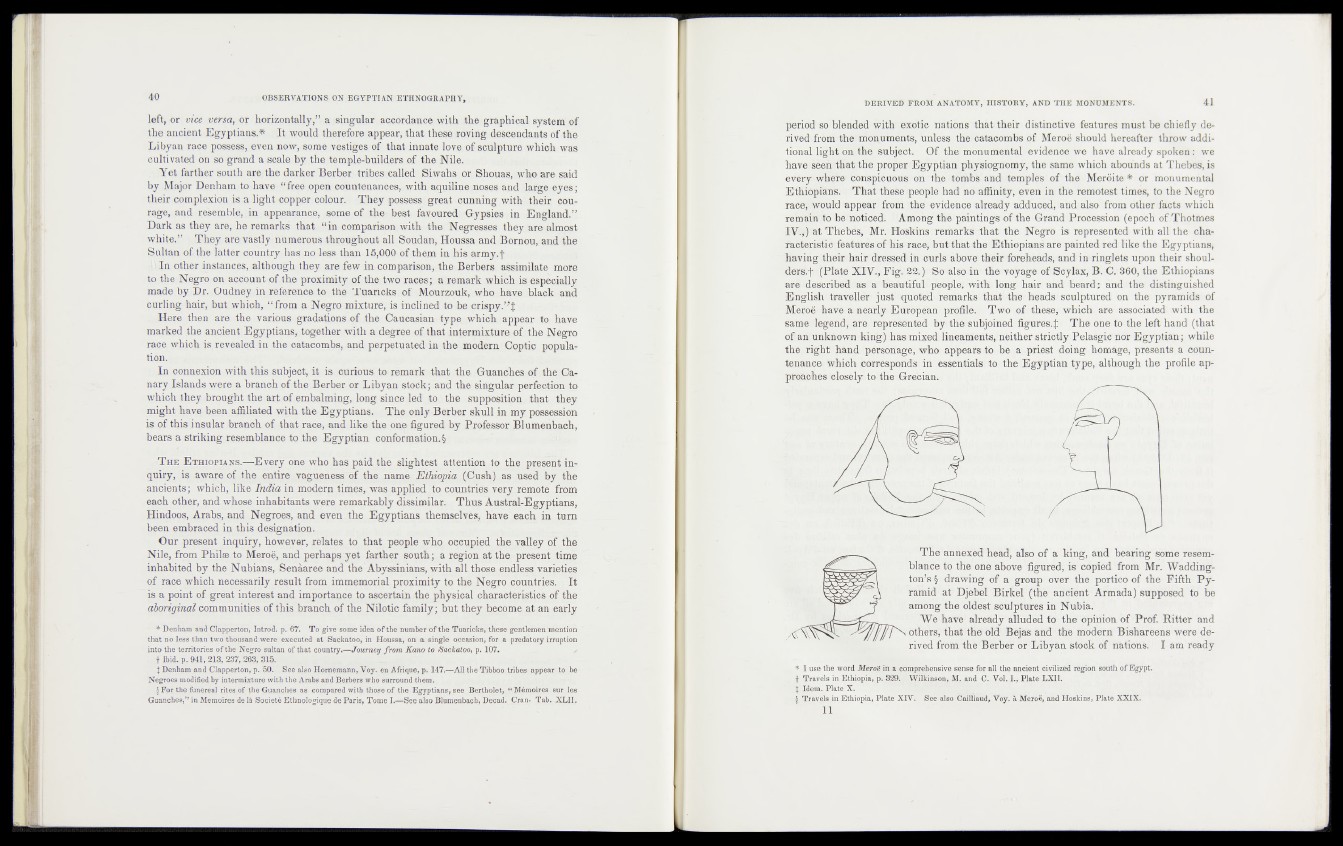
left, QTivice versef, or hprizqntallyj” &P glfifliffiÉ
the mfflpfiat iEgyptians.^ H wctald^&ftEqfcrafrppeffl», that ofrthg
Libyan, race possess, even now£&^§4v^^ige&f,gfj that innatg 0,©®^^fcsçuipture; vwtesfejwa's
cultivated on so grand a .scale.bj'ffi§jte^pfeb®ïldaïs;iGÉ the Kfile* :
É .YéfcjfaJiber sputb çg&the dfÇrker BeihelB-Jtaifeesaf6a'l led .Sviwahs OF=(B,houaS#f>vh%M%Slid
by ,^ajpr JîânJ^aHif,1p(-have ‘ ‘ frqe ,<apen; popHtqgqn%eg,r-with. aqpiine^riQsçs and. i
thejx complexion; is a l i g h t - c o p p e r , T h e y possess, gréait ».cunning ,w4th -ftheiii poy-
tage, and Ü ^ fc b p jj in j^^arjaiaqf, e s ^ g ^ tth e sb e s t; .faypsEgdigGiypsies in :J§nglibd»4i~
D a r t as tbèy-f^,uh§ remarks tbat^andcOmparison with the-, 'Negresses jlkgy yre alrqqst
white.^,%s^bgy,are yastlyb^^r^sASQWgheubatlvShidàl^ H<aussa;and Bernou, and'fhe
SnMajiî ofcthe rigljert.equity- ha^nj^fejgr thaïe Mi&QQ <af ‘thegapp, îhi| -armyrib««
ti» f e qth^jg ^p eg s,,a lth o u g h fthe-y^^ÿjfe,eomparison,^%Berbers assimilate* more
t,o feejIfegro'fl^^®®at-,ofitBg proxirm^^fgdagitwo races jj-Jl^ena^rk which igj especially
made by,'Dr. ^udaapyHki reference#)i^b^fLlùa5içks.oft-MQuraqüki'who have^M^gfetarid
eullina -h^iîbufâ^îcib^, I - from a NpgjiCFmixture'^is inkçltnfeds®> h o crispy 41*1; ale
-, Here. tH§j|| are, the various,gradations;.of thp Caucasian^ typets^b^béappear^gf^^e
maEke|£|the.aaoienttEgyptians.,,together .w.ith-ajdegrèeaof that, in|ér,m.i'Yti i re pf the î ^ f p
racq-^hicdfcds^e^i^d|in the c^tacQmbs,.and,.f|qrpetuated in the medeia- Gpptic mo.pula-
tiëOjgT
#*frr -that. the,î.Gûan©hestQf#hie ^ a -
nary,Islande y^eréwbf^ftbpIdbfô^erbèr iq^Libyan stock; and t , h ar\penfer,b&ri-faj
which \he^bjoug^t*-the art of embalming-, Jong since led to the supposition that they*
might havj^hqeniaffllated with the-Egyptians^i:: Th^pply^Berber j ^ i l l injmp possession,
is of this'insular branch, of;-that race,»andriikpj the one. figured-by ■BrofassorrBliamen.hacb-
bears a strikingxresemblance to .tho Egyptian -Gqnfcpnakom&i ,.t,
,*The Eiiiioi’U N g ^ ^ sm y ono who has paid the, slightest attention 4o th(yresp.0lt.nV-
guiry, isf^waprèxq^ the^MLtke^jagueness qf3 .the .^ame3 as. ,use"<î;l) j |® |
ancients; wh^H like Inaiff, in^mqdern.times^ was applied-tm^mSVi^;y&wj:emote from
e a o E q ll^ qqd whose,-inhabitants were remarkably dissimilar? r Thus Austral-Egyptians,
Hindoos, Arahs^and .Jtpgrpgs,.ran.d ,eyen the Egyptians themselves^ Have each, im t^ujen
been embraced,in this designation.
Our present inquipf? however, relates to that peopie.jWbq, occupied the^ valley ofrithe
Nile, from Phike-fto Meroë, and „perhaps yet farther south; a region at thee présent time
inhabited qid the Nubians,. Sgnaaisqejand the A by ssi ni ans, wi th al I th
pf rqqe .yhich, necessarily,.result from immemorial proximity to the Negro .countries. It
is a point of great interest and importance to ascertain the physical clWanteristics pf the
aboriginal comm.unities.oJdb^branch of the Nilotic family; but they, become at an early
* * Deithom ^Ba^appertcrir, Introd. p. 67. To give some idea' o f the number of the Tuaricfee, tkesé‘^ ili|iiW lT O è ittfi
that no less than two thousand were executed al Sackatoo, in Houssa, on a single occasion, for a pWdsto%^igffipilA
into the territories of the Negro saltan ot tfiat country.—Journey from Kano to' Sackatoo, p. 107.
f Ibid. p. 941,21§, 23% 263, §I5;,-,v,
J Denham .and Clappertonrp. 50.-, Seelaiso Hornemann, Voy. en Afrique, p. 147^Alfcthe'Tibbop_tribes appear -to, be
Negroes modified by intermixture with the Arabs and Berbers who surround them.
t riJI-VÇthe funereal rites of the Guanches as compared with those o f the Egyptians, see Bertholet, “ Mémoires sur les
Guanches,’’ in Mémoires de IS Société Ethnologique de Paris, Tome I.—“See also Blumenbach, Decad. Cran- Tab. XLII.
IbbM^vga'TOnM^itivy.itb exotic fidtions thafithleite distinctive features must be chiefly de-
BiTfedift^^tpbsi^onfaments unless catacombs df> M'eroe should hereafter throw addi-
gfturiitl b <> ^ ^ ' pf-tlie^monmiaent-aifeviderieet, we have already spoken: we
have; see®* that the,prope5*E^prabnl'physiogn&my, the same which abounds at Thebes, is
ev^i®jWliefo',@0n1s|feu'aU^(^^toe ttonfobgiakdh temples of the Meroite * or monumental
EbEieiffiiduS.'• '»Tfefat thekelpebpl<MMrab%ffiiiiity; even in the remotest times, to the Negro
radepkssiuld 'a-ppearifr&bi /ad’dhrebdj; an’d' also from other facts which
rfehiS^^wSbein'oticbiti liA4noug4he paiMMugfesoftthe Grand Procession (epoch of Thotmes
THefe'Is,' MnaM^slCiffsiiMibaMcsilthats-the Negro is represented with all the characteristic
features of^pisiTapeii bht*Aatithei’Ethiopians are painted red like the Egyptians,
haviBg-t'heiiekfaib3(ic6^ged.%iS^S.^l^®beiv^lfbSi^‘fctifehb&d"si'andrin ringlets upon their shoul-
der^ri' "’(Plate ctffBeylax,!»BlJO. 360, the Ethiopians
areP@e^5B»hed as»'® hW’hSnwNppfel^^lMft||^^hair'ail'd beard; and the distinguished
®n^Mh traveller»? heads.' sculptured on the pyramids of
Mi loo li n e a^nep%WIji^o[p(^f4pi^^}Mterjis®u3!f<ti’,1,lhesei}',whi6hdare associated with the
feraetd'egend,, JiPKeprelPiitedWbikthe subjoined f i g o n e - t o the left'hand (that
oflanjunknown kin^)ihdscmixed lineaaieiits, neither strictly Pelasgic'nor Egyptian; while
•th^|M^htfoha<m.difpeijsfe'fi'riige. who appears tbi be as-jlffifsit ^ I p g biiuadge, pteseiltS a coun-
tgrifpkfej fehlcb'ifclrEes,pbridsi;in .essentials, to- the'Egyptian ^.j^e, although th© profile ap-
"P$&bhftsdelQselyr W ^ f i tG r b c i n n ? ! i
' 11 ^The 'annexed head, alsd of a sking, and bearing some resem-
JijitTOiS tB the1 bne above 'figured! is ueqpreoirffo m Mr. Wadding-
ton'sr^diawing’ol a "group ove# tK^ porticos ofi the Fifth Pyramid
at? D'je^fe'PBirkel1 (the ancient Armada) supposed to be
among the oldest sculptures'in Nkibia? -■
'We^-nave'' already alluded tof the:1dpffiidn bf Prof. Ritter and
%t®ers? ^baft'the' eld' Bejas and th'e mb'erefn Bishareens were derived
f^^tne»"Berber of Libyan¥tbdk of^nations. I am ready
* I use the word Meroë in a comprehensive sense for all the ancient civilized region south of Egypt.
Travels in EÜiii^^B). 3â9h>v^'^^êàsonv'Mf And Vol.f J., Plate LXI1.
| cTdem. Plate
l TravelslinvEfeqpl^Pli^^^p^ ee'alsB^ ^^S^ d/^Voÿ. à Mefoe,,aiid Hoskins, Plate XXIX. v
11